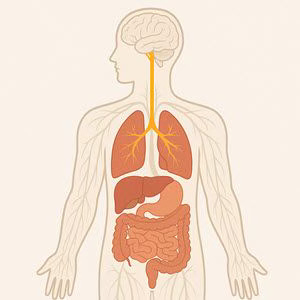The Vagus Nerve: Why Chiropractors Love It
The vagus nerve might not get the same attention as the spine, but for many chiropractors, it's a favorite. It's long, winding, and carries messages between the brain and vital organs. It affects breathing, digestion, heart rhythm, immunity, and even how calm or anxious someone feels.
It begins in the brainstem and weaves its way through the neck and chest, down into the belly. Along the way, it connects with the lungs, heart, and gut. It's part of the parasympathetic nervous system, the "rest and digest" side of things. When it's functioning correctly, the body can relax, repair, and feel at ease. When it's not, people may feel edgy, experience gut issues, or find themselves stuck in a state of stress.
From the Spine to the Gut
There's a real relationship between spinal alignment and how the vagus nerve behaves. Misalignments in the spine—especially in the upper neck—can irritate the nerve or interfere with how it functions. This is one reason many patients notice improvements in digestion, mood, or sleep after chiropractic care. They often describe it as "feeling lighter," "calmer," or "like I can breathe again."
One chiropractor shared a story about a patient who came in for neck pain but left surprised to find that their heart palpitations had subsided after a few visits. Another had a long-time client with constipation who noticed more regularity and less bloating after addressing tension in the mid-back and pelvis.
These kinds of changes aren't just a coincidence. The vagus nerve regulates the movement of the digestive tract and the production of stomach acid. It also plays a significant role in reducing inflammation in the body, which affects the immune system and mood regulation.
Chiropractic's Role
Supporting the vagus nerve doesn't always mean direct contact. Gentle adjustments that help realign the spine and alleviate pressure on the nervous system can give the vagus nerve the freedom it needs to function properly. Some chiropractors also use cranial work, light touch techniques, or specific neck protocols to support vagal tone.
Vagal tone is a measure of how active and responsive the nerve is. Higher tone is generally a good thing. It means the body can shift into a relaxed state more easily. Lower tone, on the other hand, often shows up in people dealing with anxiety, poor sleep, IBS, or burnout.
Research indicates that stimulating the vagus nerve—whether through breathing exercises, cold exposure, or chiropractic adjustments—can help lower inflammation and support mental health (2).
This is why many chiropractors become excited when the vagus nerve is discussed. It's not just a nerve. It's a lifeline running from brain to body, helping everything stay in sync.
Did you know?
Did you know... the Eiffel Tower grows more than 6 inches taller in summer due to heat expansion?
Did you know... watermelon is 92% water, making it one of the most hydrating summer snacks?
Did you know... the world's largest sandcastle was built in Denmark and stood over 69 feet tall?
Did you know... bananas are technically berries, and they ripen faster in the summer heat?
Thanks for reading!



